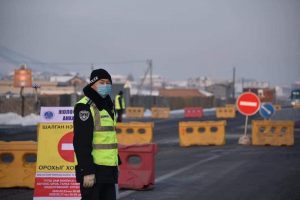On December 1, Mongolia completed 19 days of quarantine meant to stop the first cases of local transmission of COVID-19. The total number of people diagnosed with COVID-19 in Mongolia has reached 812. There have been no fatalities so far. The case count has been steadily increasing since March. The number of imported cases via repatriated citizens stands at 383 – that means the number of locally transmitted cases, following the first such case on November 11, quickly exceeded the imported cases.
When the Mongolian State Emergency Committee announced a full curfew for five days on November 12, it faced several clusters of patients with COVID-19. One cluster included a truck driver who had recently returned from Russia and underwent a 21-day quarantine at a hotel. It has since been revealed that the people who were undergoing quarantine at that hotel repeatedly violated the isolation procedures. More than 40 people have been included in this cluster.
Another cluster of COVID-19 infections was quickly pinpointed to Selenge province. Selenge is Mongolia’s northernmost province and is home to a big border crossing checkpoint with Russia. Even though the border has been closed for human traffic since March, cross-border traffic in goods has continued to operate. The border has since been closed for an indefinite period. More than 183 people have been diagnosed with COVID-19 in Selenge province.
The third and most troubling cluster occurred among railroad employees. Mongolia operates a north-to-south bound railroad that connects Russia, Mongolia, and China. The majority of people diagnosed with COVID-19 in Mongolia have been the railroad employees and their family members. The railroad passes through the provinces of Selenge, Darkhan, Orkhon, and Gobisumber.
During the 19 days of full curfew, more than 188,044 PCR and rapid tests were conducted. Mongolia has a population of 3.3 million, so the number of tests equates to 5.7 percent of the population. In Selenge, 18,000 people were tested – virtually every person in the province. Darkhan city, Mongolia’s second largest city with a population of 100,000, went a different route. They have asked people to volunteer one person for testing per family. More than 28,000 people were tested within a span of three days. Also, 16,000 personnel from the Mongolian railroad were tested.
Because the capital of Ulaanbaatar has introduced a curfew, more than 40,000 people who live outside of the city were stuck. Within a span of four days, all the people who wanted to go back were given PCR tests. Since none of them were infected, they were allowed to return and instructed to self-isolate when they reached their destination.
Mongolian government officials have been hopeful that they were able to trace and isolate all the COVID-19 patients, but to be on the safe side, they have extended the curfew for another 10 days. People have been instructed to continue to wear masks and go outside only for food and medical emergencies.
Even though the story is still not over, we can point to some lessons learned from the recent emergence of local transmission in Mongolia.
Mongolia introduced strict quarantine measures, such as closing the border and asking all citizens to wear masks, on January 25. The early recommendation to wear masks has been essential in preventing transmission of the infection. After 10 months of no local transmission of COVID-19, people and government officials alike started to relax. The strict measures that kept Mongolia safe have been abandoned. Maintaining a strict regimen is difficult to practice for many months.
Because Mongolia was able to be COVID-19 free for more than 10 months, it could prepare for the eventual cases by stockpiling masks, PPE suits, essential medicine, and respirators. Several hospitals have been designated as COVID-19 centers and the staff members were prepared to deal with patients. Mongolia has also purchased several new PCR laboratories in strategic locations close to border towns, and acquired mobile ones. The mobile laboratories were essential in the provincial towns and allowed the medical personnel to rapidly deploy and conduct tests on a short notice.
Though the medical personnel have been good thus far in tracing all the people who have been in contact with confirmed COVID-19 cases, in a big epidemic, tracing large number of people by hand would be difficult if not impossible. Utilizing tracing applications on mobile phones, similar to South Korea, will be essential. Also, because large amounts of people were being asked to use websites to check the results of their tests, the websites repeatedly crashed. Mobilizing new hi-tech methods to monitor and trace COVID-19 infections would be essential in keeping the numbers down.
Mongolia was COVID-19 free for more than 10 months. That was no accident. The strict procedures that were imposed to keep the virus at bay have worked for almost a year. But the country’s recent experience shows that maintaining high level of preparedness for a prolonged time is difficult, if not impossible.
Anandsaikhan Nyamdavaa is an independent consultant based in Ulaanbaatar, Mongolia.

































